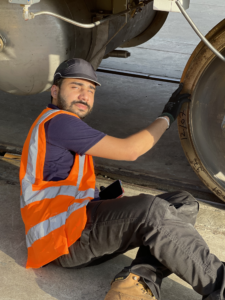Description
Rail is a costly industry prone to punctuality having issues like catastrophic failure, largely due to lack of accurate information. Locomotives are the lifeline & strength of a country or a state, they run like RBC and WBC in our blood vessels transmitting contents.
Vibration analysis is one the best practice for mechanical maintenance of products in dynamic conditions which gives room for continuous real time monitoring using developed techniques and bifurcating methods to define the correct root cause of an early failure. As per the study, continuous dynamic data capturing while an Asset is running in its full duration defines the best way to detect the accurate information using different vibration analysis methods. There are lot of ways to find out the bearing defects on Rail axles boxes, but the accurate information is acquired when a continuous monitoring of raw data is used to study the signals using the right technique. This idea of continuous/real time monitoring added wheel health detection using vibration analysis and resulted in ways to calculate the reliability of costly wheels around the locomotive industry.
This case study helped to learn about the behaviour of rail asset’s wheels surface damages with respect to time. After a year of study on a prototype asset, it was concluded that vibration mapping technique can be used to identify the sub-surface damages on the locomotive wheel differentiating the stages of damage to asset with respect to time and can help predicting the faults/failures days in advance to stop catastrophic failures surprises. This case study can also help in calculating the reliability of a rail asset and taking a leap from Preventive maintenance to Predictive maintenance.
Bio
 Ashish Arora (Ash) is an Enthusiastic Lead Application Engineer for Vibration Analysis Services Specialization in Rail/Locomotives Traction Motors, Wheel Health, Bearing Health, Track Health, Sperling Ride Quality, Gear Health, Sub-surface Defects, Structure Borne Vibration, Predictive Maintenance, Noise & Vibration Analysis and particularly Vibration Mapping having more than 10+ years of experience as a practitioner. He holds an Engineering Degree in Mechanical Engineering and specialized in Noise & Vibration Engineering, is also a member of the Condition Monitoring Society. Currently, involved in studies of Locomotive Mechanical Maintenance using ‘ Internet of Things – IOT ‘ welcoming Industry 4.0, working on the future demands of Industry. He has been involved previously in Ground Vibration, Structure Health Diagnostics, Reliability Analysis and Surface Morphology Projects with renowned clients throughout The World. He aims to develop methods which are easy to co-relate. Er. Ashish is currently working on sub-surface damages prediction using vibration analysis and bifurcating new methods for upcoming Industry needs to achieve the best practices using Predictive Mechanical Maintenance techniques.
Ashish Arora (Ash) is an Enthusiastic Lead Application Engineer for Vibration Analysis Services Specialization in Rail/Locomotives Traction Motors, Wheel Health, Bearing Health, Track Health, Sperling Ride Quality, Gear Health, Sub-surface Defects, Structure Borne Vibration, Predictive Maintenance, Noise & Vibration Analysis and particularly Vibration Mapping having more than 10+ years of experience as a practitioner. He holds an Engineering Degree in Mechanical Engineering and specialized in Noise & Vibration Engineering, is also a member of the Condition Monitoring Society. Currently, involved in studies of Locomotive Mechanical Maintenance using ‘ Internet of Things – IOT ‘ welcoming Industry 4.0, working on the future demands of Industry. He has been involved previously in Ground Vibration, Structure Health Diagnostics, Reliability Analysis and Surface Morphology Projects with renowned clients throughout The World. He aims to develop methods which are easy to co-relate. Er. Ashish is currently working on sub-surface damages prediction using vibration analysis and bifurcating new methods for upcoming Industry needs to achieve the best practices using Predictive Mechanical Maintenance techniques.